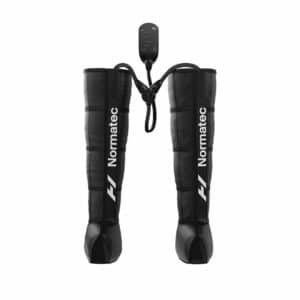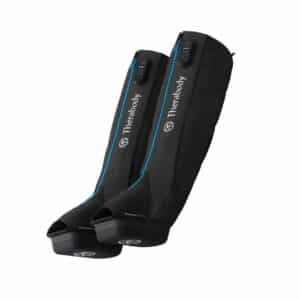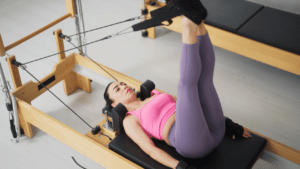
If you’re serious about hitting your training and race goals this year, don’t forget to include recovery time in your schedule. Alongside massage guns and foam rollers, compression boots are one of the most effective medical-grade tools that have recently become readily available to the mainstream.
Compression boots, also known as recovery boots, are designed to enhance circulation, reduce inflammation and soreness, and promote faster recovery after exercise. In this blog post, we will walk you through everything you need to know about choosing the best compression boots for runners. From how compression boots work, to the types available in the market, the benefits of using them, factors to consider when choosing one, and finally, how runners should use them for maximum benefits.
How Compression Boots Work
The science behind compression boots is pretty straightforward. In what’s called pneumatic compression therapy, compression boots apply pressure to specific muscles in order to increase blood flow and reduce inflammation. They work by inflating and deflating the boots, starting at your feet and moving up your legs.
Since your heart is higher than your legs, it’s more difficult for the blood to efficiently transport waste from them up to the lymphatic system which helps get rid of toxins. Compression boots speed up the process of eliminating toxins from your body by assisting with lymphatic drainage and pushing waste up your legs and then toward the lymph nodes for further processing and elimination.
Benefits of Compression Boots for Runners
When used properly and regularly, compression boots can provide a number of benefits for runners. Here are just a few:
Enhances Blood Circulation
As mentioned earlier, one of the main benefits of compression boots for runners is improved blood flow and circulation. The applied pressure from the boots helps to increase blood flow, delivering much-needed oxygen and nutrients to the muscles. This can help to reduce muscle soreness and speed up the recovery process.
Faster Recovery
By improving blood circulation, compression boots also aid in the removal of metabolic waste products, such as lactic acid, from the muscles. This helps to reduce inflammation and promote faster recovery times. Studies show that a lymphatic drainage massage can help to reduce lactic acid. According to a study published in the International Journal of Exercise Science, participants found that using a pneumatic compression device for daily treatments reduced recovery time from DOMS more effectively than wearing a compression sleeve continuously.
Reduces Muscle Fatigue
The removal of metabolic waste also helps in reducing muscle soreness. These waste products are responsible for the soreness and stiffness that you feel after a workout. According to a clinical study conducted on ultramarathon runners and published in the Journal of Orthopaedic & Sports Physical Therapy, pneumatic compression therapy after running an ultramarathon was found to be as effective as massage in reducing muscular fatigue right after the exercise. Compression boots also help to support and stabilize the muscles in the lower leg. This additional support can reduce muscle fatigue and help runners maintain proper form for longer periods. By delaying the onset of muscle fatigue, runners can push themselves harder during training and races, ultimately leading to improved performance.
Reduce swelling and inflammation
After strenuous exercise, the body begins to heal itself by mending microscopic tears in your muscles which causes swelling and inflammation. Gravity also pulls fluids down to the lower limbs, which is why lifting your legs can reduce swelling. But compression boots work even better by applying pressure on these areas and forcing fluid up and away from the legs while also preventing it from accumulating in that region. By using them regularly, you will be able to cut back on the rest time needed for recovery.
Improves Performance
When your muscles are less sore and recover faster, you can train harder and longer, which in turn leads to better performance. Compression boots help in improving performance by enhancing recovery and reducing muscle soreness.
Choosing the Right Compression Boots
When choosing the best compression boots, there are several factors to consider, including:
- Size and Fit: This might seem obvious, but you’ll need to get the proper fit. If they are too large, they won’t massage deep enough; conversely, if your boots are too small they will be very uncomfortable. Always start with the manufacturer’s size chart. You’ll usually need to know your total height and inseam length.
- Pressure Level and Intensity Settings: Depending on how rigorous your exercise or activity is, you may require a higher intensity of pressure. You should look for one with at least three setting levels. The best compression boots offer you the ability to customize and finely tune the intensity of pressure applied during each session, while some even feature isolation capabilities so that certain parts of your leg can be targeted.
- Number of Chambers: The more air chambers the boot has, the better it will be able to adapt to your leg’s shape, giving you a better massage. Look for a boot with at least four chambers.
- Recovery Modes: Look for a boot that has additional recovery modes, particularly one that specifically treats leg swelling and includes sports massage.
- Leg Coverage: Make sure the boot you choose has targeted compression zones that provide support and massage where it is needed most. If you’re looking for full-leg recovery, be sure to carefully review the descriptions and pictures of the boots you are considering. Ensure that everything from your feet up to your upper thighs is fully covered by them.
- Price: Generally, you get what you pay for. Cheaper boots may lack features or be made from inferior materials, so make sure to read reviews before settling on a model.
- Noise Levels: This is often overlooked, but some boots are louder than others. Since we’re using the boots for recovery, it’s nice not to have the added sound. Therefore, be sure to select a model with an air pump that operates as quietly as can be.
How Runners Should Use Compression Boots
Here are some guidelines on how runners should use compression boots:
- Timing: Keeping in mind that compression boots are best for muscle recovery after a taxing workout, most fitness experts say that the best time to use them is after speed work or a hard, long run. It is recommended to use them within 30 minutes to an hour after finishing a workout. However, you might also try wearing them before your workout. If you are someone that is on your feet a lot during the day, 10-15 minutes of leg compression pre-run might help flush out your legs and give you an added boost.
- Frequency: The frequency of use will depend on the runner’s training schedule and individual needs. Some runners may benefit from using compression boots every day, while others may only need to use them a few times a week. It is important to listen to your body and adjust the frequency accordingly.
- Duration: The duration of use will also depend on the runner’s needs, but generally, it is recommended to use compression boots for 20-30 minutes per session. You could also break up the session. Try wearing them for 20 minutes. If you still feel like you need more leg recovery, put them on for another 20 minutes.
- Intensity: Compression boots usually come with different intensity levels, which can be adjusted based on the runner’s preference. It is important to start at a lower intensity and gradually increase it as your body gets used to the sensation.
- Additional tips: It is recommended to hydrate before and after using compression boots, as they can increase blood flow and circulation in the body. Additionally, it is important to properly clean and maintain the boots to ensure their longevity and effectiveness.
Like any recovery method, it might take some experimentation to dial in on what works best for you. It is important to listen to your body and adjust the frequency accordingly.
Best Compression Boots for Runners
Deciding on the perfect pair of compression boots can be a daunting task for any runner. To make the process smoother, here is our list of the best compression boots for runners:
Hyperice Normatec 3
Best Compression Boots Overall
Shop Hyperice Normatec 3 on Amazon
Check out Normatec 3 deals on Hyperice
I was a bit surprised that Hyperice was able to improve on their Normatec 2 model, but they did! Their newest version, Normatec 3, features a streamlined control unit that’s lighter than the 2.0 system with a 50% longer battery life (now up to 3 hours). This revolutionary system utilizes 7 levels of compression and patented Pulse Technology to deliver precise treatment to 5 overlapping zones with something called “ZoneBoost” by mimicking the natural muscle pumps and one-way valves of the legs. Designed by an MD, PhD, this is the original, most tested, and most scientifically backed dynamic air compression system on the market.
Therabody RecoveryAir JetBoots
Best Compression Boots for Travel 
Shop Therabody RecoveryAir JetBoots on Amazon
If you’re running ultras or trail running in the backwoods, Therabody might be what you’re looking for. These compression boots are fully wireless and integrated with internal pumps, these compression boots utilize two of Therabody’s proprietary technologies – FastFlush and TruGrade. FastFlush Technology completes one full cycle of inflation and deflation in just 60 seconds, while TruGrade Technology applies precise pressure to create a safer true negative gradient from the feet to the heart and back again. Offering 4 hours of battery life and complete customization with 4-time interval options and 4 pressure settings, Therabody’s JetBoots make a nice recovery tool out on the course.
FIT KING Air Compression Boots
Best Compression Boots on a Budget
Shop FIT KING Air Boots on Amazon
If you’re looking for an effective and affordable way to get the benefits of leg compression massage, then FIT KING Leg Compression Boots are perfect for you. This upgraded version has 4 large airbag chambers that wrap your full leg in comfort. The smart sensor system precisely controls the pressure and adjusts the inflation volume to fit your individual leg size so you get the most comfortable massage experience without worrying about safety. With 3 massage modes, 8 pressure intensities, and 3 optional times for selection, you can customize your massage to fit your specific preferences and needs.
Final Thoughts on Finding the Best Compression Boots for Runners
Ideally, since compression boots can be a weighty investment, it’s best to ask around with fellow runners to get their take on how they use their compression boots and what they like most. Luckily, I belong to a sizable running club where I was able to ask for their input and even got to try out and use the compression boots that I don’t personally own.
The reviews on Amazon can be helpful as well. I researched a lot of the different compression boots available to come up with my picks and found that the reviews were generally spot on. I think most showed a personal preference as well. I hope this article helps in making your decision a bit easier.
FAQ Runners have about Compression Boots:
Do I need to wear special clothing or remove my clothes when using compression boots?
No. You don’t need to wear special clothing when using compression boots, as they are designed to be worn over regular clothes. We recommend wearing comfortable clothing that allows for a full range of motion, like compression tights, shorts, or leggings. However, for maximum comfort, it is recommended that you remove your shoes and socks, and avoid wearing anything restricting, such as tight jeans or belts, as this can interfere with the effectiveness of the therapy. Additionally, you don’t need to remove your clothes when using compression boots, but some people may be more comfortable doing so.
How soon can runners expect to see improvements in recovery with compression boots?
The timeline for experiencing noticeable improvements in recovery can vary depending on the individual’s training regimen, frequency of compression boot usage, and personal recovery needs. Some users may notice benefits immediately after the first use, while others may require consistent use over a few weeks to observe significant improvements.
Can compression boots be used to aid recovery from running-related injuries?
While compression boots can help promote recovery and alleviate muscle soreness, it is essential to consult a healthcare professional, such as a physical therapist or sports medicine specialist, before using them to address running-related injuries. They can provide specific guidance on whether compression boots are appropriate for your particular injury and recovery plan.
Are there any guidelines for using compression boots before a race or competition?
Using compression boots before a race or competition can be beneficial for some runners by promoting blood flow and reducing muscle stiffness. However, it is essential to avoid using the boots too close to the start of the event, as overstimulation may lead to muscle fatigue. Experiment with compression boot use during training to determine the optimal timing for pre-race sessions.
How are compression socks different from compression boots?
Compression boots and compression socks or sleeves serve different purposes for runners. While compression socks or sleeves provide targeted compression during running, promoting blood flow and reducing muscle vibration, compression boots focus on post-workout recovery by utilizing dynamic compression to improve circulation, alleviate muscle soreness, and reduce inflammation.
Are compression boots a substitute for other recovery methods, such as foam rolling or massage?
Compression boots can be a valuable addition to an athlete’s recovery room but should not entirely replace other recovery methods. Combining compression boot therapy with techniques like foam rolling, stretching, massage, and proper nutrition can lead to a more comprehensive and effective recovery strategy.



